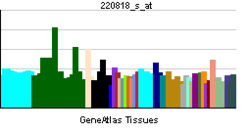TRPC4
| View/Edit Human | View/Edit Mouse |
The short transient receptor potential channel 4 (TrpC4), also known as Trp-related protein 4, is a protein that in humans is encoded by the TRPC4 gene.[5][6]
Function
TrpC4 is a member of the transient receptor potential cation channels. This protein forms a non-selective calcium-permeable cation channel that is activated by Gq-coupled receptors and tyrosine kinases, and plays a role in multiple processes including endothelial permeability, vasodilation, neurotransmitter release and cell proliferation.[7]
Tissue distribution
The nonselective cation channel TrpC4 has been shown to be present in high abundance in the cortico-limbic regions of the brain.[8] In addition, TRPC4 mRNA is present in midbrain dopaminergic neurons in the ventral tegmental area and the substantia nigra.[9]
Roles
Deletion of the trpc4 gene decreases levels of sociability in a social exploration task. These results suggest that TRPC4 may play a role in regulating social anxiety in a number of different disorders.[10] However deletion of the trpc4 gene had no impact on basic or complex strategic learning.[11] Given that the trpc4 gene is expressed in a select population of midbrain dopamine neurons it has been proposed that is may have an important role in dopamine related processes including addiction and attention.[9]
Clinical significance
Single nucleotide polymorphisms in this gene may be associated with generalized epilepsy with photosensitivity.[12]
Interactions
TRPC4 has been shown to interact with ITPR1,[13][14] TRPC1,[15][16] and TRPC5.[16]
See also
References
- ↑ "Diseases that are genetically associated with TRPC4 view/edit references on wikidata".
- ↑ "Drugs that physically interact with Short transient receptor potential channel 4 view/edit references on wikidata".
- ↑ "Human PubMed Reference:".
- ↑ "Mouse PubMed Reference:".
- ↑ Zhu X, Jiang M, Peyton M, Boulay G, Hurst R, Stefani E, Birnbaumer L (May 1996). "trp, a novel mammalian gene family essential for agonist-activated capacitative Ca2+ entry". Cell. 85 (5): 661–71. doi:10.1016/S0092-8674(00)81233-7. PMID 8646775.
- ↑ Clapham DE, Julius D, Montell C, Schultz G (December 2005). "International Union of Pharmacology. XLIX. Nomenclature and structure-function relationships of transient receptor potential channels". Pharmacol. Rev. 57 (4): 427–50. doi:10.1124/pr.57.4.6. PMID 16382100.
- ↑ "Entrez Gene: transient receptor potential cation channel, subfamily C, member 4".
- ↑ Fowler MA, Sidiropoulou K, Ozkan ED, Phillips CW, Cooper DC (2007). "Corticolimbic expression of TRPC4 and TRPC5 channels in the rodent brain". PLoS ONE. 2 (6): e573. doi:10.1371/journal.pone.0000573. PMC 1892805
 . PMID 17593972.
. PMID 17593972. - 1 2 Cooper D, Illig K, Varnell A, Ostertag E, Klipec W (2011). "TRPC4 ion channel protein is selectively expressed in a subpopulation of dopamine neurons in the ventral tegmental area". Nature Precedings. doi:10.1038/npre.2011.6577.1.
- ↑ Cooper D, Rasmus K, Wang J-G, Varnell A, Ostertag E (2011). "Sociability is decreased following deletion of the trpc4 gene". Nature Precedings. doi:10.1038/npre.2011.6367.1.
- ↑ Cooper D, Collins M, Drish A, Swenson L, Ostertag E, Klipec W, Nguyen P, Deeney B, Williamson C, Wenzel K, Stumme J (2012). "Deletion of the trpc4 gene and its role in simple and complex strategic learning". Nature Precedings. doi:10.1038/npre.2012.6929.1.
- ↑ von Spiczak S, Muhle H, Helbig I, de Kovel CG, Hampe J, Gaus V, Koeleman BP, Lindhout D, Schreiber S, Sander T, Stephani U (September 2010). "Association study of TRPC4 as a candidate gene for generalized epilepsy with photosensitivity". Neuromolecular Med. 12 (3): 292–9. doi:10.1007/s12017-010-8122-x. PMID 20574736.
- ↑ Yuan JP, Kiselyov K, Shin DM, Chen J, Shcheynikov N, Kang SH, Dehoff MH, Schwarz MK, Seeburg PH, Muallem S, Worley PF (September 2003). "Homer binds TRPC family channels and is required for gating of TRPC1 by IP3 receptors". Cell. 114 (6): 777–89. doi:10.1016/S0092-8674(03)00716-5. PMID 14505576.
- ↑ Mery L, Magnino F, Schmidt K, Krause KH, Dufour JF (January 2001). "Alternative splice variants of hTrp4 differentially interact with the C-terminal portion of the inositol 1,4,5-trisphosphate receptors". FEBS Lett. 487 (3): 377–83. doi:10.1016/S0014-5793(00)02362-0. PMID 11163362.
- ↑ Strübing C, Krapivinsky G, Krapivinsky L, Clapham DE (October 2003). "Formation of novel TRPC channels by complex subunit interactions in embryonic brain". J. Biol. Chem. 278 (40): 39014–9. doi:10.1074/jbc.M306705200. PMID 12857742.
- 1 2 Hofmann T, Schaefer M, Schultz G, Gudermann T (May 2002). "Subunit composition of mammalian transient receptor potential channels in living cells". Proc. Natl. Acad. Sci. U.S.A. 99 (11): 7461–6. doi:10.1073/pnas.102596199. PMC 124253
 . PMID 12032305.
. PMID 12032305.
Further reading
- Islam, Md. Shahidul (January 2011). Transient Receptor Potential Channels. Advances in Experimental Medicine and Biology. 704. Berlin: Springer. p. 700. ISBN 978-94-007-0264-6.
- Clapham DE, Julius D, Montell C, Schultz G (2006). "International Union of Pharmacology. XLIX. Nomenclature and structure-function relationships of transient receptor potential channels.". Pharmacol. Rev. 57 (4): 427–50. doi:10.1124/pr.57.4.6. PMID 16382100.
- Cavalié A (2007). "Ionic channels formed by TRPC4.". Handb Exp Pharmacol. Handbook of Experimental Pharmacology. 179 (179): 93–108. doi:10.1007/978-3-540-34891-7_5. ISBN 978-3-540-34889-4. PMID 17217052.
|chapter=ignored (help)
External links
- TRPC4 protein, human at the US National Library of Medicine Medical Subject Headings (MeSH)
This article incorporates text from the United States National Library of Medicine, which is in the public domain.

